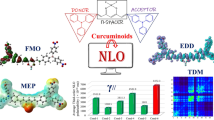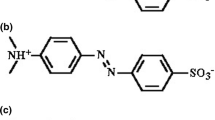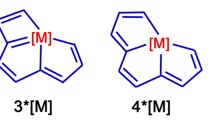Abstract
Discovery of novel materials with excellent second-order nonlinear optical (NLO) properties is a very attractive topic in chemistry and materials science. Recently, much more attention has been paid to chiral compounds due to their inherent asymmetric structure and intramolecular charge transfer. Currently, the density functional theory (DFT) has become a powerful methodology to rationalize experimental observations and to design new materials with desirable properties. In this work, on the basis of the reported chiral peropyrene, we designed another five compounds consisting of donor or acceptor moieties and the donor/acceptor combinations. We systematically studied their geometrical/electronic structures and electronic transition/second-order NLO properties. The measured UV–Vis/CD spectra of compound 1 are almost reproduced by our calculations, enabling us to assign its electronic transition property and absolute configuration. For these compounds, the different substituents have great effect on their photophysical properties (i.e., band gap, absorption wavelength, and NLO response). The charge transfer synergy provides some useful information for further performance improvement. Interestingly, compound 6 shows a remarkably large first hyperpolarizability value of 18.14 × 10−30 esu. Our research enables an opportunity for understanding the structure–property relationship of chiral peropyrenes.

The nonlinear optical properties of the studied compounds were studied with the aid of the DFT calculations




Similar content being viewed by others
References
Turitsyn SK, Bednyakova AE, Fedoruk MP et al (2015) Inverse four-wave mixing and self-parametric amplification in optical fibre. Nat Photonics 9:608
Sergeyev A, Geiss R, Solntsev AS et al (2015) Enhancing guided second-harmonic light in lithium niobate nanowires. ACS Photonics 2:687–691
Dalton LR, Sullivan PA, Bale DH (2010) Electric field poled organic electro-optic materials: state of the art and future prospects. Chem Rev 110:25–55
Luo J, Huang S, Shi Z et al (2011) Tailored organic electro-optic materials and their hybrid systems for device applications. Chem Mater 23:544–553
Ramya K, Saraswathi NT, Raja CR (2016) Growth and characterization of an organic nonlinear optical material: L-Histidine malonate. Opt Laser Technol 84:102–106
Lai C-C, Lo C-Y, Huang J-Z et al (2018) Architecting a nonlinear hybrid crystal–glass metamaterial fiber for all-optical photonic integration. J Mater Chem C 6:1659–1669
Sun H, Wu J, Jiang Z et al (2018) Design, synthesis, and properties of nonlinear optical chromophores based on a verbenone bridge with a novel dendritic acceptor. J Mater Chem C 6:2840–2847
Kamada K, Ueda M, Nagao H et al (2000) Molecular design for organic nonlinear optics: polarizability and hyperpolarizabilities of furan homologues investigated by ab initio molecular orbital method. J Phys Chem A 104:4723–4734
Hu C, Chen Z, Xiao H et al (2017) Synthesis and characterization of a novel indoline based nonlinear optical chromophore with excellent electro-optic activity and high thermal stability by modifying the π-conjugated bridges. J Mater Chem C 5:5111–5118
Tao K, Wu Z, Han S et al (2018) Switchable behaviors of quadratic nonlinear optical properties originating from bi-step phase transitions in a molecule-based crystal. J Mater Chem C 6:4150–4155
Edappadikkunnummal S, Nherakkayyil SN, Kuttippurath V et al (2017) Surface Plasmon assisted enhancement in the nonlinear optical properties of phenothiazine by gold nanoparticle. J Phys Chem C 121:26976–26986
Hu L, Wei D, Huang X (2017) Second harmonic generation property of monolayer TMDCs and its potential application in producing terahertz radiation. J Chem Phys 147:244701
Sifain AE, Tadesse LF, Bjorgaard JA et al (2017) Cooperative enhancement of the nonlinear optical response in conjugated energetic materials: a TD-DFT study. J Chem Phys 146:114308
Champagne B, Plaquet A, Pozzo J-L et al (2012) Nonlinear optical molecular switches as selective cation sensors. J Am Chem Soc 134:8101–8103
Gingras M (2013) One hundred years of helicene chemistry. Part 3: applications and properties of carbohelicenes. Chem Soc Rev 42:1051–1095
Botek E, André J-M, Champagne B et al (2005) Mixed electric-magnetic second-order nonlinear optical response of helicenes. J Chem Phys 122:234713
Marks TJ, Ratner MA (1995) Design, synthesis, and properties of molecule-based assemblies with large second-order optical nonlinearities. Angew Chem Int Ed Eng 34:155–173
Kim SY, Lee M, Boo BH (1998) Second molecular hyperpolarizability of 2,2′-diamino-7,7′-dinitro-9,9′- spirobifluorene: an experimental study on third-order nonlinear optical properties of a spiroconjugated dimer. J Chem Phys 109:2593–2595
Liao J-Z, Chen D-C, Li F et al (2013) From achiral tetrazolate-based tectons to chiral coordination networks: effects of substituents on the structures and NLO properties. CrystEngComm 15:8180–8185
Wenbo W, Conggang L, Gui Y et al (2012) High-generation second-order nonlinear optical (NLO) dendrimers that contain isolation chromophores: convenient synthesis by using click chemistry and their increased NLO effects. Chem Eur J 18:11019–11028
Cornelis D, Franz E, Asselberghs I et al (2011) Interchromophoric interactions in chiral X-type π-conjugated oligomers: a linear and nonlinear optical study. J Am Chem Soc 133:1317–1327
Verbiest T, Elshocht SV, Kauranen M et al (1998) Strong enhancement of nonlinear optical properties through supramolecular chirality. Science 282:913
Haupert LM, Simpson GJ (2009) Chirality in nonlinear optics. Annu Rev Phys Chem 60:345–365
Iazzolino A, Ould Hamouda A, Naïm A et al (2017) Nonlinear optical properties and application of a chiral and photostimulable iron (II) compound. Appl Phys Lett 110:161908
Fischer P, Hache F (2005) Nonlinear optical spectroscopy of chiral molecules. Chirality 17:421–437
Buckley LE, Coe BJ, Rusanova D et al (2017) Ferrocenyl helquats: unusual chiral organometallic nonlinear optical chromophores. Dalton Trans 46:1052–1064
Coe BJ, Rusanova D, Joshi VD et al (2016) Helquat dyes: Helicene-like push–pull systems with large second-order nonlinear optical responses. J Org Chem 81:1912–1920
Gossauer A, Nydegger F, Kiss T et al (2004) Synthesis, chiroptical properties, and solid-state structure determination of two new chiral dipyrrin difluoroboryl chelates. J Am Chem Soc 126:1772–1780
Gossauer A, Fehr F, Nydegger F, Stöckli-Evans H (1997) Synthesis and conformational studies of urobilin difluoroboron complexes. Unprecedented solvent-dependent chiroptical properties of the BF2 chelate of an urobilinoid analogue1. J Am Chem Soc 119:1599–1608
Toyoda M, Imai Y, Mori T (2016) Propeller chirality of boron heptaaryldipyrromethene: unprecedented supramolecular dimerization and chiroptical properties. J Phys Chem Lett 8:42–48
Han X, Zhang J, Huang J et al (2018) Chiral induction in covalent organic frameworks. Nat Commun 9:1294
Nichols VM, Rodriguez MT, Piland GB et al (2013) Assessing the potential of Peropyrene as a singlet fission material: Photophysical properties in solution and the solid state. J Phys Chem C 117:16802–16810
Martínez-Abadía M, Antonicelli G, Saeki A, Mateo-Alonso A (2018) Readily processable hole-transporting peropyrene gels. Angew Chem Int Ed 57:8209–8213
Wenzel U, Löhmannsröben H-G (1996) Photophysical and fluorescence quenching properties of peropyrene in solution. J Photochem Photobiol A Chem 96:13–18
Uchida K, Kubo T, Yamanaka D et al (2017) Synthesis, crystal structure, and photophysical properties of 2, 9-disubstituted peropyrene derivatives. Can J Chem 95:432–444
Yang W, Longhi G, Abbate S et al (2017) Chiral peropyrene: synthesis, structure, and properties. J Am Chem Soc 139:13102–13109
Frisch MJ, Trucks GW, Schlegel HB, Scuseria GE, Robb MA, Cheeseman JR, Scalmani G, Barone V, Mennucci B, Petersson GA et al (2010) Gaussian 09, revision E.01. Gaussian, Inc, Wallingford
Becke AD (1988) Density-functional exchange-energy approximation with correct asymptotic behavior. Phys Rev A 38:3098–3100
Becke AD (1993) Density-functional thermochemistry. III. The role of exact exchange. J Chem Phys 98:5648–5652
Lee C, Yang W, Parr RG (1988) Development of the Colle-Salvetti correlation-energy formula into a functional of the electron density. Phys Rev B 37:785–789
Liu C, Si Y, Shi S et al (2016) Understanding the photophysical properties of chiral dinuclear Re(i) complexes and the role of Re(i) in their complexes. Dalton Trans 45:7285–7293
Liu C, Yang G, Si Y et al (2017) Understanding photophysical properties of chiral conjugated corrals for organic photovoltaics. J Mater Chem C 5:3495–3502
Si Y, Yang G (2014) Nonplanar donor–acceptor chiral molecules with large second-order optical nonlinearities: 1, 1, 4, 4-tetracyanobuta-1, 3-diene derivatives. J Phys Chem A 118:1094–1102
Jacquemin D, Mennucci B, Adamo C (2011) Excited-state calculations with TD-DFT: from benchmarks to simulations in complex environments. Phys Chem Chem Phys 13:16987–16998
Guido C, Jacquemin D, Adamo C, Mennucci B (2015) Electronic excitations in solution: the interplay between state specific approaches and a time-dependent density functional theory description. J Chem Theory Comput 11:5782–5790
Azarias C, Cupellini L, Belhboub A et al (2018) Modelling excitation energy transfer in covalently linked molecular dyads containing a BODIPY unit and a macrocycle. Phys Chem Chem Phys 20:1993–2008
Jebnouni A, Chemli M, Lévêque P et al (2018) Effects of vinylene and azomethine bridges on optical, theoretical electronic structure and electrical properties of new anthracene and carbazole based π-conjugated molecules. Org Electron 56:96–110
Azarias C, Pawelek M, Jacquemin D (2017) Structural and optical properties of subporphyrinoids: a TD-DFT study. J Phys Chem A 121:4306–4317
Jacquemin D, Perpete EA, Scuseria GE et al (2008) TD-DFT performance for the visible absorption spectra of organic dyes: conventional versus long-range hybrids. J Chem Theory Comput 4:123–135
Mançois F, Sanguinet L, Pozzo J-L et al (2007) Acido-triggered nonlinear optical switches: benzazolo-oxazolidines. J Phys Chem B 111:9795–9802
Plaquet A, Guillaume M, Champagne B et al (2008) In silico optimization of merocyanine-spiropyran compounds as second-order nonlinear optical molecular switches. Phys Chem Chem Phys 10:6223–6232
de Wergifosse M, de Ruyck J, Champagne B (2014) How the second-order nonlinear optical response of the collagen triple helix appears: a theoretical investigation. J Phys Chem C 118:8595–8602
Beaujean P, Bondu F, Plaquet A et al (2016) Oxazines: a new class of second-order nonlinear optical switches. J Am Chem Soc 138:5052–5062
Chopra P, Carlacci L, King HF, Prasad PN (1989) Ab initio calculations of polarizabilities and second hyperpolarizabilities in organic molecules with extended. pi.-electron conjugation. J Phys Chem 93:7120–7130
Dapprich S, Frenking G (1995) Investigation of donor-acceptor interactions: a charge decomposition analysis using fragment molecular orbitals. J Phys Chem 99:9352–9362
Scalmani G, Frisch MJ, Mennucci B et al (2006) Geometries and properties of excited states in the gas phase and in solution: theory and application of a time-dependent density functional theory polarizable continuum model. J Chem Phys 124:094107
Furche F, Ahlrichs R (2004) Time-dependent density functional methods for excited state properties (vol 117, pg 7433, 2002). J Chem Phys 121:12772–12773
Jacquemin D, Adamo C (2012) Basis set and functional effects on excited-state properties: three bicyclic chromogens as working examples. Int J Quantum Chem 112:2135–2141
Li X (2018) Design of novel graphdiyne-based materials with large second-order nonlinear optical properties. J Mater Chem C 6:7576–7583
Yanai T, Tew DP, Handy NC (2004) A new hybrid exchange–correlation functional using the coulomb-attenuating method (CAM-B3LYP). Chem Phys Lett 393:51–57
Chen J-L, Hong J-T, Wu K-J, Hu W-P (2009) The MC-DFT approach to the M06-2X, B2K-PLYP, and B2T-PLYP functionals. Chem Phys Lett 468:307–312
Becke AD (1993) A new mixing of Hartree–Fock and local density-functional theories. J Chem Phys 98:1372–1377
Goerigk L, Hansen A, Bauer C et al (2017) A look at the density functional theory zoo with the advanced GMTKN55 database for general main group thermochemistry, kinetics and noncovalent interactions. Phys Chem Chem Phys 19:32184–32215
Chai J-D, Head-Gordon M (2008) Long-range corrected hybrid density functionals with damped atom–atom dispersion corrections. Phys Chem Chem Phys 10:6615
Mardirossian N, Head-Gordon M (2017) Thirty years of density functional theory in computational chemistry: an overview and extensive assessment of 200 density functionals. Mol Phys 115:2315–2372
Pedone A (2013) Role of solvent on charge transfer in 7-aminocoumarin dyes: new hints from TD-CAM-B3LYP and state specific PCM calculations. J Chem Theory Comput 9:4087–4096
Nayyar IH, Masunov AE, Tretiak S (2013) Comparison of TD-DFT methods for the calculation of two-photon absorption spectra of oligophenylvinylenes. J Phys Chem C 117:18170–18189
Kodikara MS, Stranger R, Humphrey MG (2018) Long-range corrected DFT calculations of first hyperpolarizabilities and excitation energies of metal alkynyl complexes. ChemPhysChem 19:1537–1546
Torrent-Sucarrat M, Anglada J, Luis J (2011) Evaluation of the nonlinear optical properties for annulenes with Huckel and Mobius topologies. J Chem Theory Comput 7:3935–3943
de Wergifosse M, Champagne B (2011) Electron correlation effects on the first hyperpolarizability of push-pull pi-conjugated systems. J Chem Phys 134:074113
Jacquemin D, Perpète EA, Medved’ M et al (2007) First hyperpolarizability of polymethineimine with long-range corrected functionals. J Chem Phys 126:191108
Champagne B, Perpete EA, Jacquemin D et al (2000) Assessment of conventional density functional schemes for computing the dipole moment and (hyper) polarizabilities of push− pull π-conjugated systems. J Phys Chem A 104:4755–4763
David R. Kanis, Mark A. Ratner, Tobin J. Marks, (1994) Design and construction of molecular assemblies with large second-order optical nonlinearities. Quantum chemical aspects. Chemical Reviews 94 (1):195-242
Acknowledgments
This work is supported by the Natural Science Foundation of China under Nos. 21573037, 21873017, 11704062, 11534003, and 51732003, the Postdoctoral Science Foundation of China under grant 2013 M541283, the Natural Science Foundation of Jilin Province (20150101042JC and 20190201231JC), and the Education Department of Jilin Province, China, under Grant number 2016511.
Author information
Authors and Affiliations
Corresponding author
Additional information
Publisher’s note
Springer Nature remains neutral with regard to jurisdictional claims in published maps and institutional affiliations.
Electronic supplementary material
ESM 1
(DOC 2440 kb)
Rights and permissions
About this article
Cite this article
Gong, L., Liu, C., Du, X. et al. Electronic structure and second-order nonlinear optical property of chiral peropyrenes. J Mol Model 25, 220 (2019). https://doi.org/10.1007/s00894-019-4106-4
Received:
Accepted:
Published:
DOI: https://doi.org/10.1007/s00894-019-4106-4




